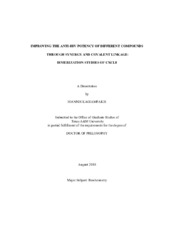| dc.contributor.advisor | LiWang, Patricia | |
| dc.contributor.advisor | Scholtz, Martin J. | |
| dc.creator | Kagiampakis, Ioannis | |
| dc.date.accessioned | 2011-10-21T22:03:28Z | |
| dc.date.accessioned | 2011-10-22T07:10:01Z | |
| dc.date.available | 2011-10-21T22:03:28Z | |
| dc.date.available | 2011-10-22T07:10:01Z | |
| dc.date.created | 2010-08 | |
| dc.date.issued | 2011-10-21 | |
| dc.date.submitted | August 2010 | |
| dc.identifier.uri | https://hdl.handle.net/1969.1/ETD-TAMU-2010-08-8512 | |
| dc.description.abstract | In the first part of my dissertation we focused on the development of covalently
linking compounds that bind gp120 with those that bind gp41 in order to block HIV
fusion. We used griffithsin or CD4M33, that both bind to gp120, covalently linked with
C-peptide C37 of gp41. The results show the linked compound Griff37 is several-fold
more potent than griffithsin alone in both fusion and viral assay, making Griff37 an
attractive candidate for further development as a microbicide against HIV.
In the second part of my dissertation we investigate the effect of combining HIV
fusion inhibitors having differing mechanisms of action. We used P2-RANTES and
RANTES that both bind to the chemokine receptor CCR5 on the surface of the human
cells along with C-peptides C37 and C34 that bind the viral envelop glycoprotein gp41.
We found that the combination of RANTES with C37/C34 has an additive effect on
fusion assay. In contrast P2-RANTES and C37/C34 shows synergy in inhibition of cell
fusion. In viral assays using MAGI cells the synergy between P2-RANTES and C37/C34
is minimal.
In the third part of my dissertation we focused on characterization of two
examples of evolutionarily conserved unfavorable sequence motifs that affect quaternary
structure. In contrast to the straightforward action of favorable sequences, these
unfavorable motifs produce interactions disfavoring one outcome to indirectly promote
another one. To identify such motifs, we propose and developed a statistically validated
computational method combining structure and phylogeny. This approach was applied in
an analysis of the alternate forms of homodimerization exhibited in the chemokine
family. We identified two evolutionarily conserved sequence motifs in the CC
subfamilies: a drastic two-residue deletion (ERV) and a simple point mutation (V27R).
Cloned into the CXCL8 background, these two motifs were experimentally proven to
confer a monomeric state. NMR analyses indicate that these variants are structured in
solution and retain the chemokine fold. Structurally, the motifs retain a chemokine
tertiary fold while introducing unfavorable quaternary interactions that inhibit CXCL8
dimerization. | en |
| dc.format.mimetype | application/pdf | |
| dc.language.iso | en_US | |
| dc.subject | GRFT, Griff37, CXCL8, HIV-1, fusion inhibitors, CD4M33 | en |
| dc.title | Improving the Anti-HIV Potency of Different Compounds through Synergy and Covalent Linkage: Dimerization Studies of CXCL8 | en |
| dc.type | Thesis | en |
| thesis.degree.department | Biochemistry and Biophysics | en |
| thesis.degree.discipline | Biochemistry | en |
| thesis.degree.grantor | Texas A&M University | en |
| thesis.degree.name | Doctor of Philosophy | en |
| thesis.degree.level | Doctoral | en |
| dc.contributor.committeeMember | Polymenis, Michael | |
| dc.contributor.committeeMember | Panin, Vlad | |
| dc.type.genre | thesis | en |
| dc.type.material | text | en |


